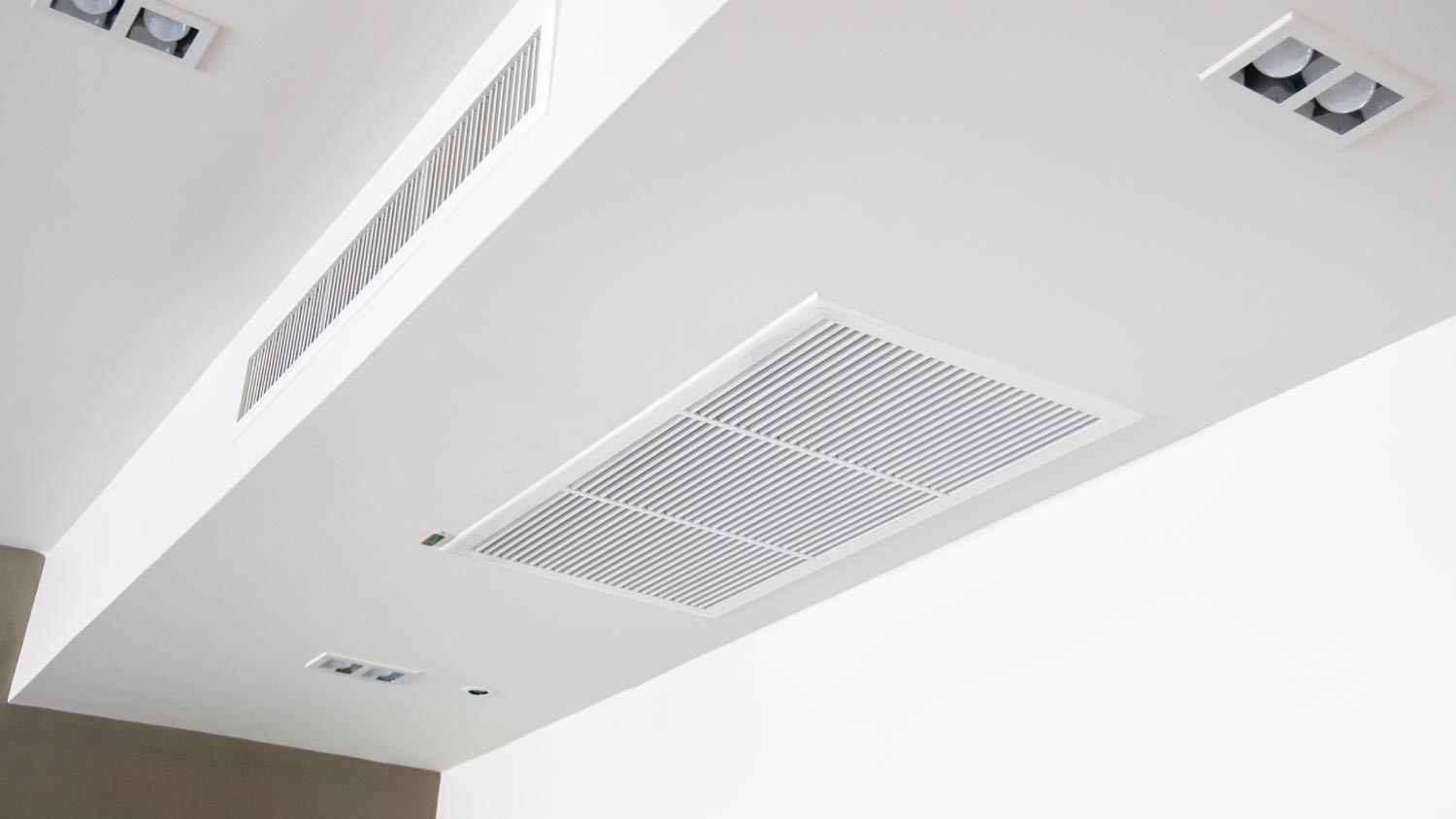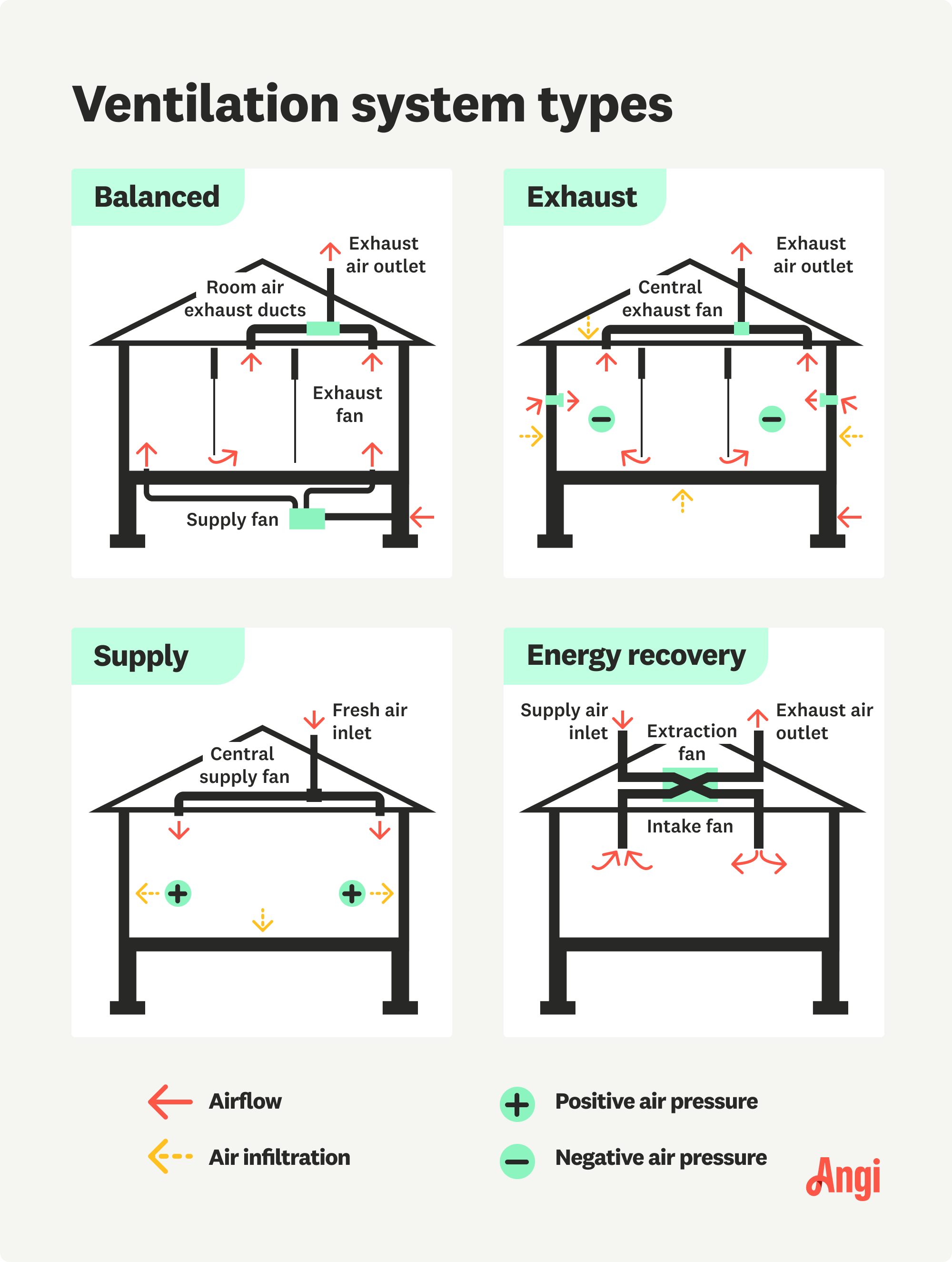
Find out the average humidifier repair cost, what impacts pricing, and how to save. Get expert tips to budget for your humidifier repair.
Breathe easy with a healthy home ventilation system


A whole-home ventilation system improves your indoor air quality.
It uses ducts and fans to bring clean air into your home and expel stale air.
There are four main types of whole-house ventilation systems.
Exhaust-only and supply-only ventilation systems are simpler and less expensive.
Balanced ventilation and energy recovery systems are more extensive.
You might not think about the air you breathe inside your home, but its quality plays a huge role in your health and well-being. But installing the right home ventilation system can keep the indoor air quality fresh and safe to breathe. Ventilation inside a home occurs in one of three ways: natural ventilation, spot ventilation, or whole-house ventilation. Out of those methods, whole-house ventilation is the most efficient way to circulate fresh air in your home. Here, we dive into the question, “What is whole-house ventilation?” We’ll also break down the four types of whole-house ventilation systems so you can decide which one is right for you.

A home ventilation system essentially acts as your home’s lungs, inhaling fresh air and exhaling stale air. A ventilation system consists of mechanical fans and vents that send and receive air. The air is sent through ductwork and dispersed throughout your entire home.
These are the three methods for indoor air circulation:
Natural ventilation occurs as air naturally moves in and out of a home, either through cracks or holes in the walls or through open windows and doors.
Spot ventilation is ventilation confined to a specific location with an exhaust fan, like a bathroom fan or stove vent hood.
Whole-house ventilation is performed with a system of ducts and fans that circulate air mechanically throughout an entire home. A whole-house ventilation system is the best option for removing moisture, improving indoor air quality, and creating more energy-efficient homes.
For our purposes, we’ll focus on four different types of whole-house ventilation systems so you can decide which one is right for you.
A whole-house ventilation system replaces stale indoor air with fresh outdoor air, reduces allergens, and controls moisture. In short, it’s essential for improving air quality inside your home. Without one, air can become stagnant, retain pollutants, or promote mold and mildew growth.
In addition, whole-house ventilation distributes cool or warm air (depending on the season) throughout your home more effectively, improving temperature control and comfort.
There are four main types of whole-house ventilation systems, each with its pros and cons.

Exhaust-only ventilation systems work to depressurize your home and exhaust out all of the spent air. The exhausted air is then replaced through natural ventilation—air that seeps in through building openings, like cracks, holes, windows, and doors—and passive air vents located in windows and walls.
Typically, a centrally located exhaust fan collects all of the stale air and sends it out of the home through an exhaust pipe. The exhaust fan is usually connected to ductwork that travels to specific rooms where pollutants are most often created, like bathrooms and kitchens.
Exhaust-only systems are only practical in cold climates. In hot climates, the depressurization can bring moist, humid air into your home, causing condensation and moisture damage.
Pros:
Relatively inexpensive system
Simple installation process
Best suited for cold climates
Cons:
Does not remove moisture from air
Not compatible with hot climates
On the contrary, supply-only ventilation systems work to pressurize your home and force fresh air inside. Spent air leaks out through holes and cracks in the building’s facade and wall or floor vents.
Similar to an exhaust-only system, a supply-only system consists of a centrally located supply fan. A fresh air inlet pipe sends fresh air to the fan, which then distributes it throughout your home via ductwork. The ductwork usually runs to rooms most often used and in need of fresh air, like living rooms and bedrooms.
Supply-only ventilation systems are most appropriate for warm climates. The pressurization can create moisture issues in cold climates.
Pros:
More control than exhaust-only systems
Relatively inexpensive system
Simple installation process
Best suited for warm climates
Cons:
Does not remove moisture from air
Not compatible with cold climates
Balanced ventilation systems do not pressurize or depressurize but rather bring fresh air in and send polluted air out. For this reason, balanced ventilation systems are often the most adaptable and preferred option.
A balanced ventilation system has a fan and duct system for fresh air supply and a separate fan and duct system for exhaust air removal. Vents and ductwork for each system can be installed in every room, but at minimum, fresh air supply should reach living rooms and bedrooms and exhaust air removal should pull from kitchens and bathrooms.
This type of whole-house ventilation system is appropriate for all climates. The system is more costly than an exhaust-only or supply-only system as it is essentially two systems requiring two fans and twice as much ductwork.
Pros:
Compatible with all climates
Home is not pressurized or depressurized
Cons:
Expensive to install
Does not remove moisture from air
There are two kinds of energy recovery systems: energy recovery ventilators (ERV) and heat recovery systems (HRV). Both types circulate fresh air throughout your home, but ERVs can also transfer moisture to reduce humidity levels in your house.
ERV systems are better for places with hot or humid weather since they’re good at removing humidity from the air. However, they run on electricity, which can increase your energy bills—especially if you live in a mild climate or just don’t use your HVAC system very often.
On the other hand, HRV systems are the better choice if you live in a cold climate because they have defrost systems to prevent them from freezing up. ERVs don’t have that functionality.
Pros:
Improves temperature control and comfort
Options for all climates
Cons:
Could increase your electricity bills
Can be noisy
A whole-house ventilation system keeps the air in your home circulating and healthier to breathe. The right system for your home ultimately depends on your climate and budget. The least expensive options for a whole-house ventilation system are exhaust-only and supply-only systems; however, exhaust-only systems are only appropriate for cold climates and supply-only systems are only appropriate for hot climates.
If your home doesn’t reside in a cold or warm climate, you will need to opt for a balanced ventilation system or energy recovery system. However, these systems do come at a higher price tag for installation, as they require multiple fans and ductwork to supply fresh air and exhaust polluted air. You can contact a local HVAC company to learn about the different options available, and collect quotes.
If you already have one of these ventilation systems and are in need of some upgrades, you could be eligible for a rebate under the 2022 Inflation Reduction Act. The High-Efficiency Electric Home Rebate Act (HEEHRA) may cover some or all of your ventilation upgrades depending on your household’s income level.
Brionna Farney contributed to this article.
From average costs to expert advice, get all the answers you need to get your job done.

Find out the average humidifier repair cost, what impacts pricing, and how to save. Get expert tips to budget for your humidifier repair.

Switching from oil to gas heating could impact your savings. This guide will help you understand the cost to convert from an oil furnace to a gas furnace.

The average boiler installation cost depends on size, system type, and other factors. Keep reading to learn the cost of a new boiler.

Forced-air systems provide a reliable source of warmth for your home, but what is forced-air heating, exactly? Let’s break it down.

Who do you call to fix a boiler? This easy guide will help you hire the right pro for the job of fixing your boiler.

Is your furnace not blowing hot air? Find out 13 common culprits behind a cold furnace, plus tips for how to get the warm air pumping again.